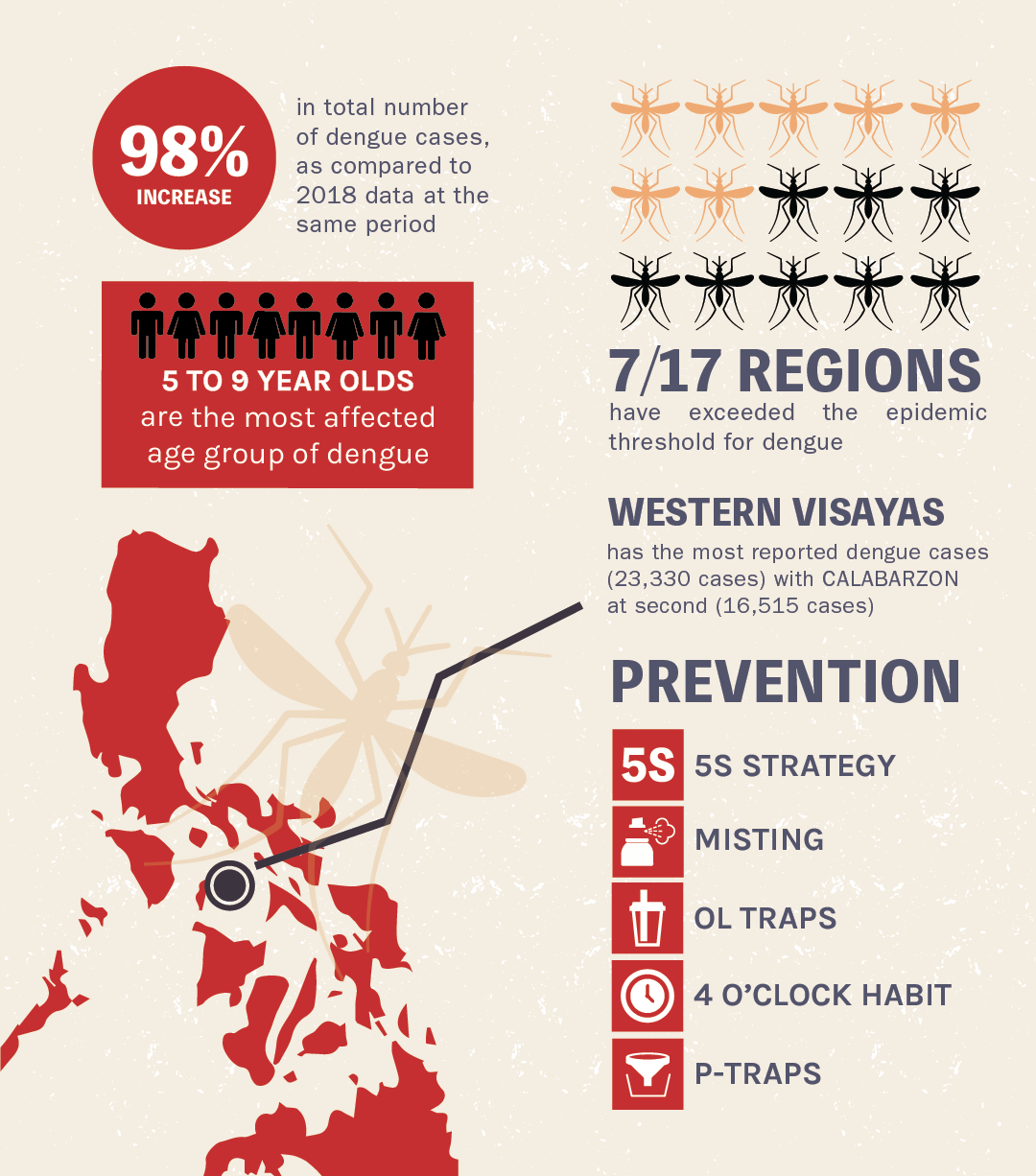LAST AUGUST 28, Ateneo Junior High School (AJHS) Principal Jonny Salvador released a memorandum informing the AJHS community about the passing of a grade eight student due to dengue.
Roughly a month later, several measures were implemented by the University to safeguard its students and staff against dengue infection. Most visible among these operations are the anti-mosquito procedures, which aim to stop the proliferation of the virus by destroying pest breeding grounds and monitoring for further infections on campus.
The implementation of these measures coincides with the ongoing alarm over dengue as a national epidemic, as declared by the Department of Health (DOH) last August 6. According to their press release, the total number of dengue cases this year has shot up by an unprecedented 98% increase in recorded instances of infection.
It is among the duties of the Ateneo as an institution comprised of distinct yet connected communities to spread local awareness of how the dengue virus proliferates and how to prevent infection, given its resources, influence, and reach.
Just one bite
The World Health Organization (WHO) classifies the dengue virus as a rapid, widespread, and viral disease carried by the female Aedes aegypti mosquito, which transmits the disease as it feeds on blood.
Mosquitoes that carry the disease typically thrive in grassland and forest-type areas and other commercial settings that contain plenty of garbage waste or lack proper sanitation. On this note, public health experts typically ascribe the Philippines’ nationally high rates of dengue infection to the plentiful mosquito spawning pools left behind by the heavy rainfall experienced during the rainy season.
On the note of public health developments within the country, the Philippine government has previously taken measures against dengue through an immunization program that was implemented in 2017. However, the pertinent organizations failed to assess the complications surrounding the Dengvaxia vaccine, resulting in medical miscalculations that were followed by the deaths of 154 children who received the medication. Although the DOH has declared that Dengvaxia is not the direct cause of these fatalities, the resulting paranoia around vaccinations has been attributed as the cause for free-falling immunization rates throughout the country. According to the DOH, last August, seven out of the Philippines’ 17 regions have already crossed the epidemic threshold for dengue cases. Metro Manila also shares its plethora of problems with the dengue outbreak, having as much as 10,103 cases as of August 2019.
Despite the developing situation of the national dengue crisis, the Loyola Schools Office of Health Services (LSOHS) Attending Physician Dr. Eric Cabrera claims that there seems to be no rise in the number of dengue cases in the University. However, the LSOHS did not provide definitive figures to support this claim. Dr. Cabrera also denies the possibility of a dengue outbreak within campus.
Other than collecting data on dengue cases on campus, the different health service units of the University have also attempted to quell future cases of infection within the community through the imposition of dengue-preventive practices. Ateneo Grade School (AGS) Infirmary Physician Dr. Pauline Santos emphasizes that the primary preventive measures against such viral infections is to impart awareness about dengue to all members of the community at large. This can be accomplished through regular health practices and habits.
For example, the DOH’s so-called 5S strategy consists of everyday precautions to suppress the spread of the virus. The Grade School Infirmary adapts this tactic by urging the AGS community to search and destroy mosquito breeding places, seek early consultation, take self-protection measures, support fogging and misting practices, and sustain proper body hydration. Meanwhile, the similarly implemented 4 o’clock habit encourages the elimination of mosquito breeding sites during dusk every day, when mosquitoes carrying the disease are noted to be most active.
A public practice
In addition to directly addressing the national paranoia surrounding dengue infection, the University’s methods of dealing with the threat of the virus also treats the sickness as a community concern.
The notion of health as a public endeavor is foremost rooted in prevention methods, specifically primary prevention, which aim to implement interventions even before the detection of the disease. More often than not, educating the community is the main goal of primary prevention.
This is particularly relevant in the case of dengue since it often manifests as non-specific symptoms: High-grade fever, weakness of the body, stomach pains, and headaches. The non-specificity of dengue infection may induce panic most often seen in the parents of children suspected to have dengue, which then results in doctors and emergency rooms becoming oversaturated with patients afflicted by otherwise benign illnesses.
As a result, effective and efficient prevention hinges on educating the community about the right course of action in identifying dengue. “Of course, [the Infirmary] understands the anxiety,” Dr. Santos remarks, “but we also want to educate the parents.” She states that there is no reason for patients to go through blood tests if the fever has lasted for only a few hours. “Seeking early consultation means if the fever has lasted two to three days alongside other symptoms.”
Beyond discussing proper dengue awareness and diagnoses within family units, public health advocates, such as the Loyola Schools’ Project LAAN, stress the need to assess such viral epidemics beyond isolated clinical cases. Project LAAN President Maxine Salita asserts that “If we look at dengue from the typical clinical perspective, we’ll be more concerned with a one-to-one ratio.” This ratio views the nature of diseases and infections on a strictly case-by-case,“doctor and patient” ratio, failing to take in the complexity of the virus. Salita notes a clear contrast between this perspective with the public health view, emphasizing how dengue as a public health crisis should be looked at through a more holistic lens. “The focus will be on things we can do to prevent it like cleaning our environment, eliminating breeding grounds, and the like.”
Dengue defense
Aside from spreading awareness about the nature of the dengue virus and its corresponding treatments and preventive measures, the University has also adapted the use of more concrete anti-mosquito measures throughout campus.
For instance, Director of the Office of Facilities and Sustainability (OFS) Engineer Elias Pan notes that the University is making use of ovicidal or larvicidal traps known as “OL traps,” as provided by the Department of Science and Technology. An OL trap consists of a stick and a scented solution placed in a cup; the scent’s purpose is to attract the female mosquito to lay eggs on the stick. As a result, the eggs and larvae exposed to the solution will die. According to Pan, the OL traps will be placed at the corners of every classroom in the Loyola Schools as well as in the University’s dormitories before October of this year.
Pan also states the OFS carries out general practices of housekeeping on the University’s buildings to ensure sanitation and cleanliness within and around campus. For example, all campus toilets are installed with “plumbing traps” to prevent both the leakage of sewer gases and the creation of mosquito spawning pools. Meanwhile, gutters and other potential basins for stagnant waters are regularly cleared out to eliminate sites of mosquito breeding.
On the other hand, the practice of “misting” classrooms is done twice a month, during which a pesticide is sprayed from a machine to kill mosquitoes and other nearby pests. In this process, windows are closed for up to two hours to allow the pesticide formulae to circulate throughout the classrooms. Engr. Pan underscores that misting is done only during non-school days, most frequently on Sundays when no classes are being held.
However, the insecticidal methods adopted by the University contrasts with the 5s and 4 o’clock strategies, where the former employs a more active approach towards addressing the concern of the mosquito breeding grounds on campus.
Technological adaptations and equipment aside, students have just as much a role as the school’s maintenance offices in preventing the virus’ spread throughout the University. Salita urges students to be more aware of different prevention methods as well as to research on whether or not they actually prove effective. She cites the use of mosquito patches as an example. “A lot of people use mosquito patches, but these aren’t scientifically proven to be effective, and may be limited in coverage.”
Pre-Medical Society of the Ateneo President Sheen Gonzales directs the Ateneo community towards health awareness in order to prevent and diagnose the impending virus accordingly. He suggests students to be mindful with “how they manage their water waste,” as well as to “protect themselves from mosquito vectors and to respond to potential hubs of disease by reporting stagnant water to the administration.” He also calls on the community to be more active in various activities concerning medicine and healthcare, most especially on national medical policies.
Ultimately, the dengue epidemic implicates everyone, both those infected and not. The challenge, then, becomes a matter of vigilance and care. “I think it’s crucial to remind people that dengue is a community issue,” Salita says. “We need to help each other out in times like this.”

Infographic by Cara Padilla
What do you think about this story? Send your comments and suggestions here: tgdn.co/2ZqqodZ







